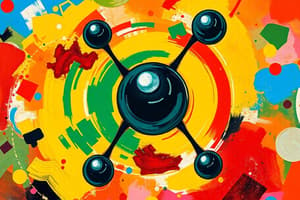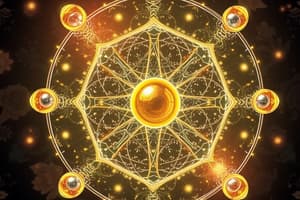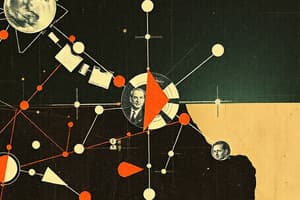Podcast
Questions and Answers
ما هو التأثير الرئيسي الذي يؤدي إلى فرق في الخصائص الفيزيائية بين النظائر؟
ما هو التأثير الرئيسي الذي يؤدي إلى فرق في الخصائص الفيزيائية بين النظائر؟
- عدد النيوترونات (correct)
- عدد الإلكترونات
- عدد البروتونات
- الشحنة الكهربائية
لماذا يكون للكربون-12 أقل تفاعلية من الكربون-14؟
لماذا يكون للكربون-12 أقل تفاعلية من الكربون-14؟
- عدد أكبر من الإلكترونات
- قوى نووية أقوى (correct)
- قوى نووية أضعف
- عدد أقل من البروتونات
ما هي دورية الذرات في تحديد كتلة واستقرار الذرة؟
ما هي دورية الذرات في تحديد كتلة واستقرار الذرة؟
- البروتونات والنيوترونات (correct)
- البروتونات والإلكترونات
- البروتونات فقط
- النيوترونات فقط
ما هو دور البروتونات داخل نواة الذرة؟
ما هو دور البروتونات داخل نواة الذرة؟
ما هي خصائص الكربون-12 في تكوين روابط كيميائية بالمقارنة مع الكربون-14؟
ما هي خصائص الكربون-12 في تكوين روابط كيميائية بالمقارنة مع الكربون-14؟
ما الفرق بين النظائر والعناصر؟
ما الفرق بين النظائر والعناصر؟
ما هو السبب وراء اختلاف كتلة النظائر لعنصر معيّن؟
ما هو السبب وراء اختلاف كتلة النظائر لعنصر معيّن؟
أيّ مكوّن يشكل نواة الذرة؟
أيّ مكوّن يشكل نواة الذرة؟
ما هي الجسيمات المشحونة إيجابيًا داخل نواة الذرة؟
ما هي الجسيمات المشحونة إيجابيًا داخل نواة الذرة؟
ما هي السمة المميزة للكربون-14؟
ما هي السمة المميزة للكربون-14؟
مَاذَا يُشكل محيط ذرة؟
مَاذَا يُشكل محيط ذرة؟
Flashcards are hidden until you start studying
Study Notes
Isotopes
Isotopes are atoms of the same element with different numbers of neutrons. While they have the same number of protons, they have varying numbers of neutrons, which gives them different masses and physical and chemical properties. Isotopes differ from different elements because elements have different numbers of protons while isotopes have the same number of protons but different numbers of neutrons. This difference between isotopes and elements can lead to confusion because the same number of protons indicates that atoms belong to the same element, but different numbers of neutrons indicate that they are different isotopes.
Isotope Masses
Isotopes have different atomic masses due to their varying numbers of neutrons. For example, carbon has three naturally occurring isotopes: carbon-12, carbon-13, and carbon-14. Carbon-14 has one more neutron than carbon-12, so it is heavier and has a higher atomic mass. Generally, the lighter isotope is more stable and abundant, while heavier isotopes are less common. The relative abundance of each isotope depends on various factors, including nuclear processes such as radioactive decay and cosmic ray bombardment.
Atomic Structure
The atomic structure of an atom consists of its nucleus, made up of protons and neutrons, and its electron orbitals surrounding the nucleus. Protons are positively charged particles found within the nucleus, while electrons are negatively charged particles orbiting the nucleus. In most cases, the number of electrons matches the number of protons, which gives the atom a neutral charge.
Physical Properties
Due to their different numbers of neutrons, isotopes have different masses and, consequently, different physical properties. For example, carbon-12 has a lower reactivity because its nuclear forces are stronger, making it difficult for it to form chemical bonds with other atoms. On the other hand, carbon-14 has a weaker nuclear force, allowing it to form chemical bonds easily when exposed to cosmic rays or during nuclear reactions. These differences result in varying physical properties among different isotopes, leading to unique applications in various fields like medicine, industry, and scientific research.
Chemical Properties
Isotopes exhibit similar chemical properties because they have the same number of protons, meaning they belong to the same element. However, their differing numbers of neutrons lead to slight variations in their reactivity and bond-forming abilities. For instance, carbon-12 forms stable bonds more easily than carbon-14 due to its stronger binding force within nuclei. As a result, isotopes may display subtle yet distinct chemical behaviors depending on their specific atomic structure.
Protons and Neutrons
Protons and neutrons play critical roles in the formation of an atom's structure and behavior. Protons are positively charged particles found inside the nucleus, while electrons orbiting around the nucleus are negatively charged. Neutrons are neutral particles that also reside within the nucleus alongside protons. The combination of these particles determines an atom's mass and overall stability.
Studying That Suits You
Use AI to generate personalized quizzes and flashcards to suit your learning preferences.




